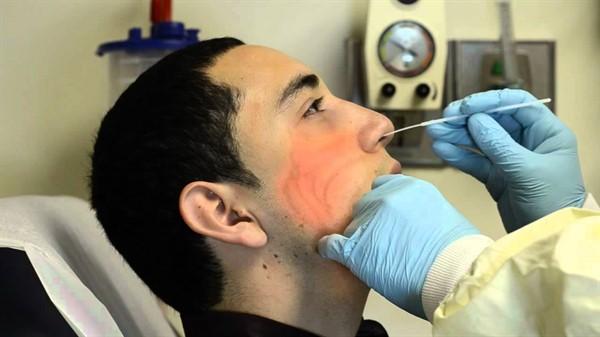Why brown snot from the nose appears in an adult - treatment
A runny nose is a common problem that often occurs with the onset of cold weather. Discharge from the nose is a symptom of one of the diseases, which is largely determined by the color of the mucus. Brown snot from the nose in an adult, as well as in a child, signal problems in the respiratory tract.
Causes
Why does brown discharge occur from the nose? The main reason for this is the inflammatory process that occurs in the paranasal sinuses - sinusitis. If the runny nose was left unattended for a long time, the mucus gradually changed - at the beginning of the inflammation it was transparent, then yellow-brown snot appeared, sometimes with a touch of rust, orange.
Important! Some mistakenly consider a runny nose to be a harmless phenomenon that passes “by itself”, ignore it until pus and blood appear. In fact, any runny nose requires treatment.
Of sinusitis, the most common are sinusitis, frontal sinusitis. With them, the discharge is dark, thick. The disease itself is also accompanied by other symptoms: pain in the nasopharynx, fever, headaches.
The destruction of the vessels of the sinuses, giving the snot a brown tint, can be provoked by:
- lack of proper treatment of common rhinitis;
- improperly performed nasal lavage, trauma to the mucous membrane;
- excessively prolonged use of vasoconstrictor drops, sprays.

Allergic rhinitis is rarely accompanied by brown discharge from the nose, with it they are usually transparent.
Brown snot in children
In children, they can occur for the same reasons as in adults. At a young age, when a child has a habit of putting small things up his nose, they often appear due to the presence of a foreign body. They can also appear as a result of an anomaly in the growth of the teeth, when the root of the tooth penetrates into the maxillary sinus. This can happen when changing children's teeth to permanent ones.
Why is the presence of a foreign body so dangerous? First, it is rejected, an inflammatory process begins, which is constantly intensifying. Secondly, this small element constantly injures the mucous membrane of the nasal cavity, while the blood released enters the nasal cavity, and the red clots turn brown at the exit.
Important! The main feature of brown discharge in the presence of a foreign body is that they flow from only one nostril, which does not look like a common cold.
Nevertheless, in most cases, brown snot is a symptom of colds resulting from infection, viruses, bacteria entering the nasopharynx.
The first specialist to contact is an otolaryngologist. The doctor conducts a survey to find out the nature of the discharge, their frequency, the duration of the problem, when they are especially intense, for example, in the morning or at night. The color of the snot should be correctly described to him, it is even important whether they are light or dark brown.
Then, using a rhinoscope, the otolaryngologist examines the nasal passages. The doctor evaluates the condition of the mucous membrane of each department, observes whether puffiness has appeared. If the cause of a runny nose is the presence of a foreign body, it is usually easy to detect during such an examination, if not, this can be done using an x-ray.

If it turns out that brown snot appeared with sinusitis, another serious cold-like illness, the doctor prescribes treatment. If necessary, other diagnostic procedures can be performed: radiography, diaphanoscopy, ultrasound, MRI. An analysis of mucus from the nasopharynx may also be prescribed.
Given that brown snot is almost always a symptom of serious illness, self-medication is out of the question. How to treat the patient, the attending physician decides after the diagnosis.
If during the examination a foreign body was found that provokes the release of mucus, it must be removed. Serious surgical intervention is not always required, sometimes an otolaryngologist can get by with his own instruments.
If the disease is provoked by prolonged use of vasoconstrictor or other similar drugs, they must be immediately canceled. A runny nose usually goes away on its own after a few days. To accelerate the desired result, general strengthening agents may be prescribed.
Important! Sometimes a runny nose occurs after a cold, as a residual effect. In this case, treatment is not prescribed.
medicines
With sinusitis, other similar diseases accompanied by brown snot, a treatment regimen is selected.

It consists of such medications:
- Vasoconstrictor drops. They are recommended to be used no longer than five days, so that addiction does not occur. They are especially effective at night to prevent nasal congestion during sleep.
- Salt solution. You can cook it yourself by washing at home, but it is more convenient for many to buy ready-made drops, sprays. Popular of them are Aqua Maris, Salin, Dolphin.
- Antibiotics. They are prescribed in cases when the patient's condition worsens, there is an increased body temperature, other alarming symptoms. One of the popular drugs is Ceftriaxone, which is available in the form of a powder for the preparation of a solution for injection.
- Anti-inflammatory, painkillers. They can be prescribed in different dosage forms - drops, sprays, tablets.
During pregnancy, breastfeeding, the basis of therapy is herbal preparations.
Folk remedies
Treatment with folk remedies can be used as an adjunct to drug therapy. They are also used to speed up the disappearance of the residual effects of a cold. If the snot is brown, green-brown, has blood clots, pus, you cannot do without the use of medications.

Such folk remedies are popular:
- washing with a decoction of chamomile;
- washing with propolis infusion;
- instillation into the nose of celandine diluted with water;
- instillation of Kalanchoe juice in its pure form;
- inhalations with herbal solutions.
Advice! Before you start using any folk remedy, you need to make sure that there is no allergy.
Prevention
To prevent a runny nose, it is necessary to devote enough time to following preventive recommendations. Doctors advise to follow these rules:
- do not overcool;
- strengthen immunity;
- do not neglect the appearance of any discomfort, pain in the nose;
- monitor the air, ensure sufficient humidity in the room;
- timely treat colds;
- do not self-medicate.
There can be many reasons for the appearance of brown snot, in most cases they occur as a result of sinusitis, advanced colds. Before treatment, it is necessary to conduct a diagnosis, finding out the exact cause of the common cold. Taking preventive measures will help prevent the return of snot.
